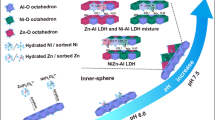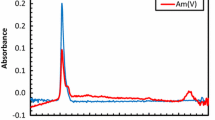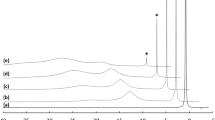Abstract
The toxic inorganic monomeric forms of aluminium (Al) that limit plant growth have been shown to be effectively detoxified by complexation with organic acid ligands released by breakdown of added organic materials. The binding capacity of these acids is dependent on the degree of dissociation of their carboxyl groups and their ability to form bonds with Al. 27Al NMR spectroscopy provides a non-invasive technique to study the bonding of Al with potential ligands without disturbing the equilibrium of the system. In single ligand systems containing oxalic acid, three 27Al resonance peaks were observed at 6.4, 11.4 and 16.0 ppm downfield from the Al3+ reference peak at 0 ppm. These were assigned to Alox, Alox2 and Alox3 complexes respectively and were observable at pH values down to 3.5. In the presence of the citrate ligand, two 27Al resonance peaks at 6.1 and 11.3 ppm, assigned respectively to the Alcit and Alcit2 complexes, were observed at pH 3.4. At pH 4.3 and an Al:citrate molar ratio of 1:2, the 6.1 ppm peak was not visible, and the second peak further downfield was split into two unresolved peaks at 10.8 and 12.4 ppm indicating the presence of two forms of the Alcit2 complex. Distribution of Al between the various species, based on integration of the resonance peaks and equilibrium calculations carried out using GEOCHEM, is discussed in light of the stability constants present in the database of GEOCHEM version (v.) 1.23 and GEOCHEM-PC v. 2.0. Large discrepancies between the computed values and the NMR measured values indicate the need to incorporate more recent literature values in the database for realistic equilibrium calculations in systems containing organic acid ligands. The potential of using quantitative 27Al NMR measurements to calculate stability constants is discussed.
Similar content being viewed by others
References
Blamey F P C, Edwards D G and Asher C J 1983 Effects of aluminum, OH:Al and P:Al molar ratios, and ionic strength on soybean root elongation in solution culture. Soil Sci. 136, 197–207.
Bertsch P M, Barnhisel R I, Thomas G W, Layton W J and Smith S L 1986 Quantitative determination of aluminum-27 by high-resolution nuclear magnetic resonance spectrometry. Anal. Chem. 58, 2583–2585.
Gregor J E and Powell H K J 1986 Aluminium (III)-citrate complexes: a potentiometric and 13C N.M.R. study. Aust. J. Chem. 39, 1851–1864.
Hue N V, Craddock G R and Adams F 1986 Effect of organic acids on aluminum toxicity in subsoils. Soil Sci. Soc. Am. J. 50, 28–34.
Kerven G L, Asher C J, Edwards D G and Ostatek-Boczynski Z 1991 Sterile solution culture techniques for aluminum toxicity studies involving organic acids. J. Plant Nutr. 14, 975–985.
Martell A E and Motekaitis R J 1988 The Determination and Use of Stability Constants. VCH Publishers, New York, USA. 213 p.
Motekaitis R J and Martell A E 1984 Complexes of aluminum (III) with hydroxy carboxylic acids. Inorg. Chem. 23, 18–23.
Nordstrom D K, Plummer L N, Wigley T M L, Wolery T J, Ball J W, Jenne E A, Basstee R L, Crerar D A, Florence T M, Fritz B, Hoffman M, Holdren G R, Lafon G M, Mattigod S V, McDuff R E, Morel F, Reddy M M, Sposito G and Thrailkill J 1979 A comparison of computerized models for equilibrium calculations in aqueous systems. In Chemical Modelling in Aqueous Systems. Ed. E A Jenne. pp 857–892. Am. Chem. Soc. Symposium Series 93. Am. Chem. Soc., USA.
Perrin D D 1979 Stability Constants of Metal-ion Complexes: Part B. Organic Ligands. IUPAC Chemical Data Series No. 22. Pergamon Press, Oxford, UK. 1263 p.
Pitluck M R, Pollard B D and Haworth D T 1987 Conditional stability constant determination of metal-fulvic acid complexes. J. Lip. Chrom. 10, 2081–2103.
Sposito G and Mattigod S V 1980 GEOCHEM: A computer program for the calculation of chemical equilibria in soil solutions and other natural water systems. The Kearney Foundation of Soil Sciences, University of California, Riverside, USA.
Stevenson F J and Ghen Y 1991 Stability constants of copper (II)-humate complexes determined by modified potentiometric titration. Soil Sci. Soc. Am. J. 55, 1586–1591.
Sun M S, Harriss D K and Magnuson V R 1980 Activity corrections for ionic equilibria in aqueous solutions. Can. J. Chem. 58, 1253–1257.
Thomas F, Masion A, Bottero J Y, Rouiller J, Genevrier F and Boubot D 1991 Aluminum (III) speciation with acetate and oxalate. A potentiometric and 27Al NMR study. Environ. Sci. Technol. 25, 1553–1559.
Author information
Authors and Affiliations
Rights and permissions
About this article
Cite this article
Kerven, G.L., Larsen, P.L., Bell, L.C. et al. Quantitative 27Al NMR spectroscopic studies of Al (III) complexes with organic acid ligands and their comparison with GEOCHEM predicted values. Plant Soil 171, 35–39 (1995). https://doi.org/10.1007/BF00009561
Issue Date:
DOI: https://doi.org/10.1007/BF00009561




